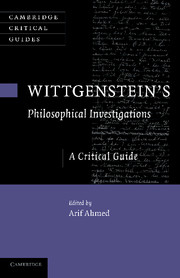Book contents
- Frontmatter
- Contents
- List of contributors
- Acknowledgments
- Introduction
- 1 From referentialism to human action: the Augustinian theory of language
- 2 What's doing? Activity, naming and Wittgenstein's response to Augustine
- 3 Measure for measure? Wittgenstein on language-game criteria and the Paris standard metre bar
- 4 Wittgenstein on family resemblance concepts
- 5 Wittgenstein on concepts
- 6 Wittgenstein vs contextualism
- 7 Wittgenstein and the linguistic turn
- 8 Rorty's Wittgenstein
- 9 Are meaning, understanding, etc. definite states?
- 10 Another strand in the private language argument
- 11 Deductive inference and aspect perception
- 12 Remembering intentions
- Bibliography
- Index
11 - Deductive inference and aspect perception
Published online by Cambridge University Press: 06 July 2010
- Frontmatter
- Contents
- List of contributors
- Acknowledgments
- Introduction
- 1 From referentialism to human action: the Augustinian theory of language
- 2 What's doing? Activity, naming and Wittgenstein's response to Augustine
- 3 Measure for measure? Wittgenstein on language-game criteria and the Paris standard metre bar
- 4 Wittgenstein on family resemblance concepts
- 5 Wittgenstein on concepts
- 6 Wittgenstein vs contextualism
- 7 Wittgenstein and the linguistic turn
- 8 Rorty's Wittgenstein
- 9 Are meaning, understanding, etc. definite states?
- 10 Another strand in the private language argument
- 11 Deductive inference and aspect perception
- 12 Remembering intentions
- Bibliography
- Index
Summary
Anyone who wanted to could see many Wittgensteinian doctrines as variations upon a single theme: that we make a certain kind of mistake. We postulate hidden properties to explain manifest relations. But really nothing is hidden: there are only the manifest relations.
Thus: an object's possible combinations with other objects is not explained by but identified with its essential nature or form (TLP 2.011–2.0141). To say what propositional variables occur ‘in’ a proposition is not to indicate properties of that proposition alone: it is to indicate with what others it shares a form (TLP 3.315–16). The future action of the machine is ‘in’ it from the start only in this sense: we have learned to derive a series of other pictures from a picture of it (PI 193). The meaning that we hear ‘in’ a musical theme can only be explained by comparison with another instance of its pattern (PI 527; CV 69–70). What expresses the sense that we ‘hear’ a word as having in a sentence is a transition to other sentences (PI 531–4). The malice we see ‘in’ a smile is not a geometrical feature of it but sometimes consists in an imaginary context (‘smiling on the suffering of an enemy’ – PI 539).
This chapter discusses another such variation: that a sentence does not have a meaning from which we derive the rules governing its deductive connection with others.
Keywords
- Type
- Chapter
- Information
- Wittgenstein's Philosophical InvestigationsA Critical Guide, pp. 197 - 217Publisher: Cambridge University PressPrint publication year: 2010
- 1
- Cited by



